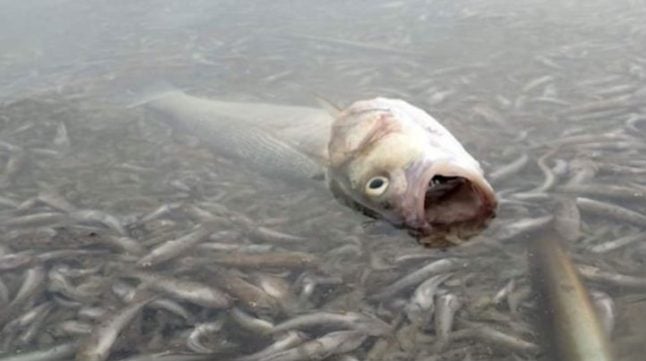Mar Menor in Murcia, Europe’s largest saltwater lagoon, is facing environmental crisis after tens of thousands of dead fish and crustaceans washed up dead on beaches in the region.
It was initially believed that the water was contaminated by a leakage of toxic substances, but this has since been disproven following Wednesday’s visit of the Minister of Ecological Transition.
Analysis of water samples taken at the lagoon revealed no signs of contamination by leaked sewage, nor were levels of E-Coli in the water considered irregular; rather, the water quality was described as “excellent” in terms of safety for humans.
Yet thousands of dead fish have washed up at Villananitos de Lo Pagánbeach, allegedly following sudden changes to the local water properties amidst the Gota Fria floods, with at least three tonnes of dead sea life being pulled from the lagoon so far.
Regional government authorities have described the lagoon as being in a “critical condition” and there is currently a red flag in the area.
Antonio Luengo, Murcia's regional minister for Water, Agriculture, Livestock, Fisheries and Environment, , has blamed the crisis on recent flooding in the area caused by irregular levels of rainfall in September.
It is thought that 60 cubic hectometers of fresh water, likely contaminated with sediment and garbage, streamed into the lagoon following the floods, depriving the lower layers of the lagoon of oxygen.
This “dead water” has reportedly spread over an area of 210 hectares, forcing live sea life to the surface before suffocating on the beach, according to animal welfare groups.
Spain's Minister for Ecological Transition, Teresa Ribera, however, has called for an investigation into the disaster, suggesting the Murcian regional government “have to be responsible and honest… and look at long term improvements”.
During her visit to the Mar Menor this week she met with environmental groups and called for agricultural practices to be improved, claiming the crisis is an “example of what happens when we look elsewhere”.
This contradicts explanations from Murcian regional government, with Luengo insisting that scientists are exploring ways to inject oxygen back into the lagoon, which is home to various endangered species, and of moving surviving fish to non-risk inland areas.
In a recent address to regional parliament, Luengo suggested increased regulation will be needed in the area, and that reviews of intensive agriculture in the region will be undertaken to ensure the preservation of the lagoon’s sea life.
More tests are to be undertaken, local government claims, including the autopsies of fish washed ashore on 12th October, the day the first fish appeared. The results are not yet available, and fishing in the lagoon was suspended last Sunday.
A petition has been started on change.org to pressure authorities into taking measures to protect the Mar Menor.
¡¡¡SOS Mar Menor!!! Exigimos medidas urgentes – https://t.co/Ngum6vdcVp #SOSmarMenor @mitecogob @regiondemurcia @LopezMirasF – ¡Firma la petición! https://t.co/BgnzItmc6Z
— Flow (@yobadac) October 16, 2019
READ ALSO: IMAGES: Southern Spain hit by worst floods in living memory
By Conor Patrick Faulkner



 Please whitelist us to continue reading.
Please whitelist us to continue reading.
Member comments